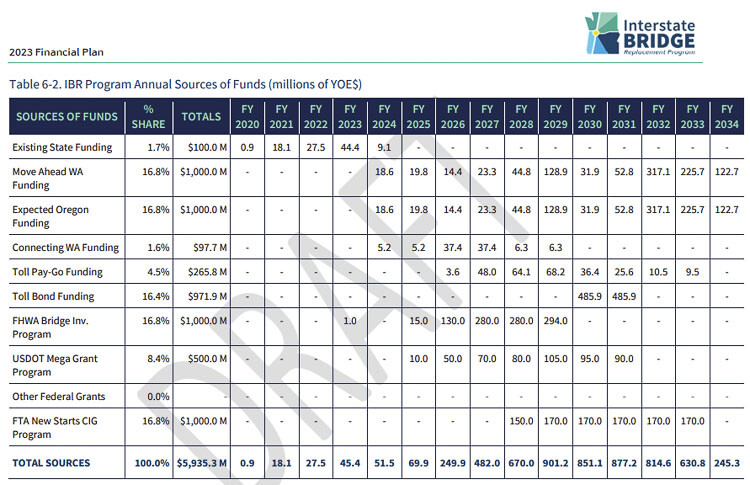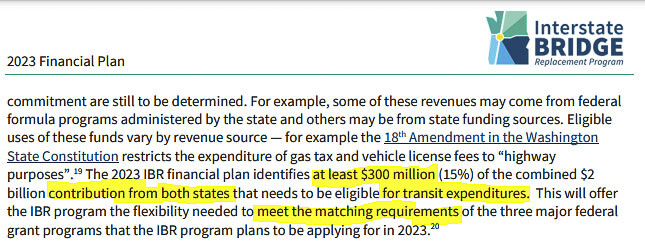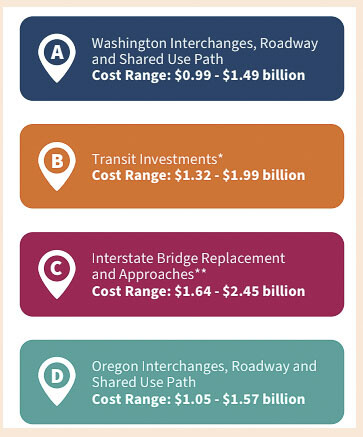
Washington to pay $150 million towards IBR light rail extension
John Ley
For Clark County Today
The Interstate Bridge Replacement (IBR) program has chosen a 3-mile extension of TriMet’s MAX Yellow line light rail as its high capacity transit option for the project. The IBR estimate is that the cost will be between $1.3 billion and $1.99 billion. How will they pay for this?
The March 2023 finance plan released by the IBR indicates Washington citizens will contribute 15 percent or $150 million of the $1 billion the Washington State Legislature allocated. The plan also requires Oregon to contribute a similar 15 percent towards the cost of the MAX light rail extension.
Previously revealed information breaks down the cost of the $5 billion to $7.5 billion project into four major subgroups:
- The bridge will cost $500 million, with the total bridge replacement and approaches costing between $1.64 to $2.45 billion.
- Light rail, labeled as “Transit Investments” is the second largest cost at $1.32 to $1.99 billion.
- Washington interchanges and roadways will cost between $990 million to $1.49 billion.
- Oregon roadways and interchanges will cost between $1.05 billion and $1.57 billion, approximately $100 million more than Washington state’s interchanges.

IBR Administrator Greg Johnson has told the program’s Executive Steering Group that federal dollars are usually the last money committed. Local money must be committed to a project first before the federal government will agree to commit funds to a project.
The entire project is often viewed as one big bucket of money. The IBR updated initial cost estimates last December. The new cost range for the project will range between $5 billion and $7.5 billion, with a “likely” cost of $6 billion. The $2.5 billion variance exceeds the cost of the light rail extension.
To pay for the transit component, the IBR hopes to get $1 billion from the Federal Transit Administration (FTA). The FTA’s Capital Investment Grant will contribute funds up to a maximum of 60 percent of a transit project cost. That means the two states would potentially have to contribute $530 million to $800 million for transit. The IBR’s financial plan hopes to begin receiving federal funding in Fiscal Year 2028 through 2033.
Tolling revenues are expected to contribute $266 million in pre-construction tolling beginning in 2026. The IBR will go to Wall Street and borrow an additional $972 million in FY 2030-31. Tolling revenues will pay back those borrowed funds.
The finance plans show transit costing a total of $1.834 billion of a $6 billion project. Furthermore, page 27 states:
”It is possible that some of the Oregon funding contribution may be sourced from state highway funds, which are restricted by the state constitution and are disallowed from being used for most transit-related expenditures or projects. The 2023 IBR financial plan identifies at least $300 million (15%) of the combined $2 billion contribution from both states that needs to be eligible for transit expenditures. This would offer the IBR program the flexibility needed to meet the matching requirements of the three major federal grant programs that the IBR program plans to be applying for in 2023.’’
A footnote states: “The $300 million of transit eligible state funding assumes that the program receives a $500 million USDOT Mega grant and a $1 billion FTA CIG award; a lesser amount from either of these grant programs would require a larger share of transit eligible state funding.”

The Oregon State Legislature is in the final two weeks of their regular session which ends June 25th. Thirteen Republican and independent senators have walked away, denying a quorum in the state senate. It is therefore unlikely the Oregon legislature will pass legislation allocating the needed $1 billion in funding for the IBR.
As the IBR noted, Oregon state highway funds are restricted by the state constitution and disallowed from being used for most transit projects. However, Oregon Department of Transportation (ODOT) officials believe tolling revenue, while generally for roads and bridges, can be used for some parts of light rail.
An August 2020 ODOT tolling presentation by Travis Brouwer included the following. “Construction of shared-purpose lanes that include light rail — although the cost of light rail only improvements within the lane (such as the rail itself) would not be eligible to be paid with State Highway Fund dollars.” This would include paying for transit stops and transit stations.
During the Columbia River Crossing debate a decade ago, some studies estimated Southwest Washington citizens could be paying up to 60 percent of bridge tolls. With Oregon officials hoping to create a “per mile” toll via their Regional Mobility Pricing Program, this would take additional money from over 75,000 Clark County citizens who commute to Oregon for work.
Portland economist Joe Cortright has reported that the double tolls could cost as much as $14 to $15 dollars each way to travel from Vancouver to Wilsonville. There would be one toll for using bridges – the Interstate Bridge on I-5, or the Abernethy and Tualatin bridges on I-205. Then there would be a separate “per mile” charge to drive each interstate.
The potential exists that $150 million is merely the beginning of Washington citizen’s money used to pay for light rail and other Oregon transit components.
Also read:
- Busy pavement season ahead on Vancouver streetsThe city of Vancouver is set to repave and preserve 76 lane miles across 20 neighborhoods in summer 2025, with ADA upgrades and community notices throughout.
- State representative: Expect sticker shock when Interstate Bridge project officials reveal price, tolling plansAt a town hall in Battle Ground, Rep. John Ley warned of major cost increases and tolling burdens tied to the Interstate Bridge replacement project.
- Opinion: Washington state lawmakers increase the cost of driving – againBob Pishue of Mountain States Policy Center argues that new vehicle and fuel taxes in Washington will raise driving costs while diverting funds away from roads.
- Overnight full closure of I-5 near Woodland for bridge inspection, May 6WSDOT will fully close southbound I-5 near Woodland overnight on Tuesday, May 6 for a bridge inspection using a chain drag test.
- Opinion: Do we still need TriMet?John A. Charles Jr. of the Cascade Policy Institute argues that TriMet should halt expansion plans and prepare for major service reductions in response to falling ridership and rising costs.










The IBR schemer’s disconnect from reality appears to have no limits. Roughly $500 million per mile for a light rail extension with insufficient capacity, declining ridership, safety concerns, and previous rejections by Clark County voters. Shameful!
The insanity of the “Light Rail Rapid Transit” on the replacement IBR continues. Looking at a map of the Trimet Rail System, it appears that the yellow line does not offer a convenient connection to the red, blue or red lines. The Yellow Line turns away and thus misses the Rose Quarter Transit Center where connections are made with the other lines. It seems like Bus Rapid Transit could stop at the end of the yellow line at Expo Center than terminate directly at the Rose Quarter Transit center allowing better connections to all the major Trimet routes. But of course, the “big money” expenditures on “light rail rapid transit” is always the “preferred” means as dictated by those who wish to squander taxpayer dollars.
Seems like a good investment. I don’t see hand wringing over the billions that will be spent on interchanges. This region is growing rapidly and we need to have better transit options for those who can’t or choose not too drive. We need to be thinking long term and having a dedicated transit option aligns with that.
you don’t need light rail. It is a waste of money, TAX Payer Money. You also need additional bridges not just replace an existing bridge. Why is it those in charge can not figure basic concepts? The amount of money these people have wasted and cost tax payers from their many years talking about this they could have built multiple additional bridges by now.
If there was better more adequate public transit that would be great. They need to replace that bridge because it’s over 150 years old and not suited for modern vehicles. They also need to raise the speed limit to meet the standard of todays cars. However the reality of the situation is that it should be either state raising the state tax for Oregon they need to raise the city tax and not put the burden on the people.